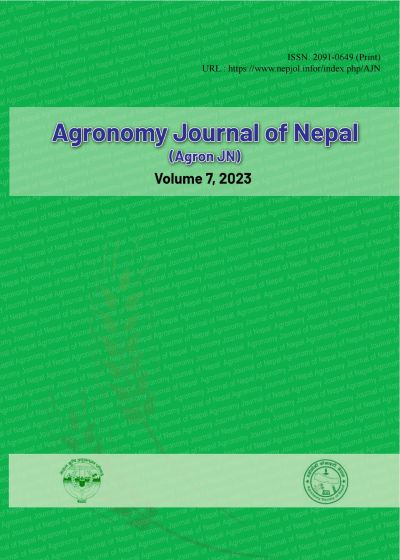Leaf Color Chart Can Increase Productivity and Foster Climate Smart Agriculture in Rice: A Case Study
DOI:
https://doi.org/10.3126/ajn.v7i1.62066Keywords:
Crop growth, LCC, Nitrogen management, NUE, rice-based system, Grain yieldAbstract
Optimum nitrogen application has been a major challenge to enhance agricultural productivity and sustainability in rice cultivation of Nepal. Nitrogen fertilizer must be applied only when necessary and must be based on the crop’s nitrogen requirement. Losses of nitrogen from rice field can cause air pollutant production, global warming and climate change. Leaf Color Chart (LCC) poses potential climate smart practice in rice field. The use of LCC is a low cost and viable method for managing nitrogen in real time, enhancing the nitrogen use efficiency. To demonstrate the effectiveness of LCC based urea application for nitrogen management in rice, a field experiment was conducted at Masala Bali Bikash Kendra, Panchkhal from June to November, 2022. Variety selected for field experimentation was Makawanpur-1. The experiment compared government-recommended urea application with LCC-based application for which field was divided into two equal plots (300 sq m). Morphological growth was measured at different stages of rice and yield was taken at maturity. In rice, LCC-based urea application led to taller plants (128.5 cm) compared to blanket urea application (115.56 cm) at harvest. LCC-based urea application also had 34% more leaves (126) and 54.5% higher effective tiller count (17). Despite the same rate of nitrogen application, yield was 35% higher in LCC based practice (4694.73 kg ha-1) than government recommended practice. Real time nitrogen application in splits based on LCC management led to better plant growth and yield, while fixed-time nitrogen application regardless of crop need in conventional blanket application resulted in nitrogen loss and lower yield. Considering the effect of nitrogen application through LCC management on rice productivity, it's clear that LCC offers valuable chances to enhance nitrogen use efficiency, rice yield, and farmers' profits.
Downloads
Downloads
Published
How to Cite
Issue
Section
License
Copyright (c) 2023 Agronomy Society of Nepal (ASoN)

This work is licensed under a Creative Commons Attribution-NonCommercial 4.0 International License.
ASON permits for free use, distribution and reproduction in any medium if the original work is properly cited and not used for commercial purposes.




